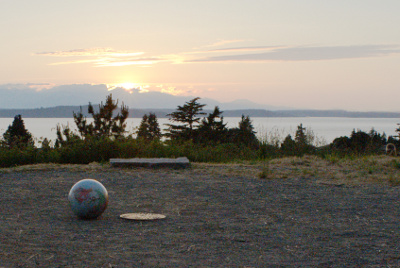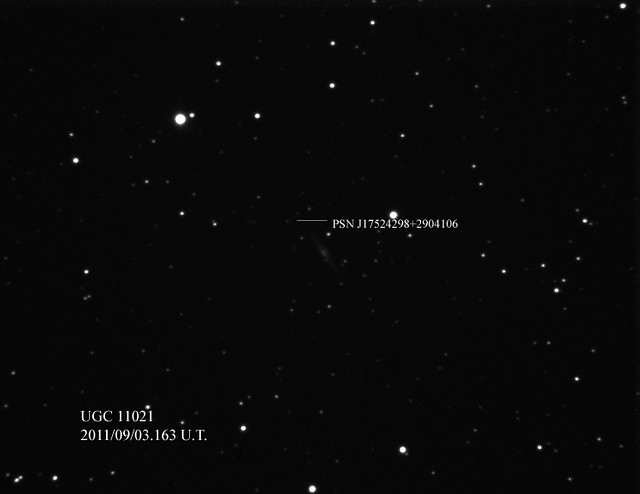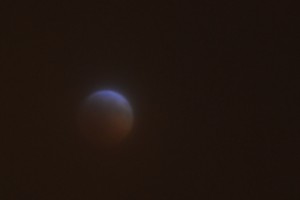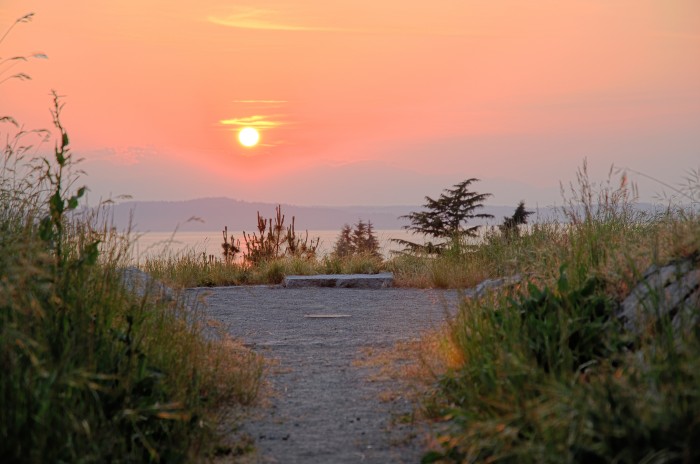Archive for the ‘AstroInfo Article’ Category
 My Star Exploded Last Week
My Star Exploded Last Week
My star¹ exploded² sometime in the week preceding last Monday³.
Let me repeat that because it is awesome.
MY STAR EXPLODED LAST WEEK!!!!!!!!!!!
¹My star: back in the summer of 2000 I had the fortune to be working as an undergraduate peon researcher in an astrophysics lab at MIT. In my seemingly endless hours sifting through data I found a previously-unidentified star (technically “source”) which we creatively named XTEJ1837+037. I have ever since referred to this as “my star” assuming it was such a pointless little dot that no one would care if I claimed the credit or not. It’s pretty close to Vega, and might be a binary system – a star orbiting a black hole or neutron star. It is perhaps more accurate to say “there was an explosion at my star.”
²Exploded: I’m being very loose with the definition of “exploded” here. NASA’s SWIFT Telescope detected an outburst near the coordinates of “my star.” This does not mean my star exploded, but something did something at that location. If it is a binary system then this outburst could easily be material from the regular star falling onto the black hole/neutron star companion.
³Sometime in the week preceding last Monday: SWIFT detected the burst between September 25, 2011 and October 15, 2011. Well, that means the light got to Earth two weeks ago – but as to when the burst actually happened? To know that we’d have to know how far away “my star” is.
Basic Stats
Source: an unidentified x-ray source, probably a binary system of a star and a neutron star and a black hole.
Name: XTEJ1837+037 or SWIFTJ1836.6+0341
Satellite used: first XTE, the X-Ray Timing Explorer, now SWIFT from NASA
What happened: a burst in the same area was detected using the burst-detecting instrument onboard SWIFT.
When: the detection occurred between September 25 and October 15, 2011.
Where in the sky: near Vega.
Where in the galaxy/universe: we don’t know. It could be in the galaxy, or it could be farther. It is probably in our galaxy, likely at least one kiloparsec away (far).
More Details and More Story
My Unidentified X-Ray Source
Source just means there’s a point in the sky that photons are coming from. The Sun is an identified and named source of visible light, radio waves, x-rays … etc. I was working under Ron Remillard at MIT at the time we found this source, and I was searching through data from the X-Ray Timing Explorer (XTE) to see if I could find gamma ray bursts for his research. I call it a star above because it was not an outburst like we were looking for, this object was steady – not something that shone brightly and then disappeared. The quickest and easiest name for that is “star.” It is important to note that we were using an x-ray telescope to do this research. This star was not visible – it shone only in x-rays, and it was very dim which is why it had not been found before.
I still asked Ron what constellation it was in. To me, even though the star wasn’t visible, being able to look towards it or point towards it was important. I don’t think Ron understood why. I know it isn’t visible. I also know it is there. It’s by Vega, at right ascension 18 degrees 37 minutes and declination +37 degrees.
We even got to name it. Ron explained how this would work. We named it XTEJ 1837+037, there was no discussion or debate, the name is formulaic. XTE is the name of the satellite used. J is there to let you know what years the coordinates are good for. In this case the coordinates are good during epoch J (12:00 Universal Time on January 1, 2000). 1837+037 are the coordinates: right ascension and declination (which can be positive or negative).
It is still an “unidentified source” because we didn’t take the time to figure out what it was. It wasn’t what we were looking for. Dr. Hans Krimm who recently rediscovered it with SWIFT speculates that it is probably a binary system – a regular star orbiting a black hole or neutron star. That would explain the recent outburst.
An Outburst
As I said, we actually have no idea what happened yet, and I am no longer involved in this research. NASA’s SWIFT telescope detected an outburst in that same area. In Hans’s words – SWIFT detected an outburst only 1.3 arc minutes from “my star.” That means it is very likely it is the same source.
With a binary system including a regular star and a black hole or neutron star, material can fall off the star and into the black hole or onto the neutron star. This is a catastrophic event, although not destructive to the binary system, and can easily create a large outburst. In fact, it is one of the types of supernovae. (Oops, I was confused. Type 1a supernovae are caused by mass falling from a star in a binary system onto a white dwarf not a neutron star or black hole. It can still create an outburst though.)
Stay tuned, I’ll be keeping up to date on this research. I hope you’re excited too!
Want More?
This is where it gets intense. The only links I have to point out to you are very, very technical. It took me three tries to read the first sentence of the first one … which could have something to do with how excited I was. Have fun deciphering!
The Astronomers Telegram and the second one.
Here are some more tractable links about the spacecraft in question:
![]()
~ A l i c e !
 Neutrinos Faster than Light?
Neutrinos Faster than Light?
The scientists running the OPERA detector in Italy detected some neutrinos from CERN 60 nanoseconds before photons travelling the same distance would have arrived. Hmm. Such data would indicate that the neutrinos are travelling faster than light. Hmm. Extraordinary claims require extraordinary evidence. These scientists are asking other scientists in the field to find the mistake in their research – so that’s ongoing.
Is This New?
We’ve seen this before. Neutrinos do not interact with anything (pretty much) – they sail through solid rock like it is empty space. Photons do interact, that’s why you can see. Imagine a race between two particle-people “N” and “P.” First, let’s have them both in empty space. They race from the Sun to the Earth (zoom!) and P wins by a bit. So we know P is faster. Now, let’s give P a handicap. P is going to race by swimming through molasses, while N still gets to run the race in empty space. Now who wins? Well, in this case N does, because he’s not hampered by the molasses. It is just like that with photons, they’re slowed down as they interact with matter – the Sun, the Earth, the solar wind, whatever is out there. The neutrinos just zip right through. So neutrinos from the middle of the Sun get to the Earth long before photons from the middle of the Sun – the photons have to get through all that Sun-material first. Neutrinos and photons from the surface of the Sun would arrive at Earth at about the same time though, because it’s mostly just space in between.
Three Ideas
Three ideas about these FTL (faster than light) neutrinos:
1) They’re not faster than light, they’re just not interacting and the light is. This idea is simplistic and too easy for the scientists not to have ruled it out already.
2) Measurement error. As per the Bad Astronomer, these scientists need to measure the distance to within 3 meters exactly. Is that possible? Maybe. If they’re off by more than 3 meters, those 60 nanoseconds are probably just error.
3) The speed of neutrinos is pretty darn close to the speed of light, maybe our measurements before weren’t sensitive enough to pick up that the speed limit of the universe is the speed of neutrinos, not the speed of light. Now we have to go rewrite all of science fiction in addition to all of physics. What a pain.
Pretty much everyone is unconvinced, but no one has come up with a problem in the scientific evidence yet.
Want More?
The Actual Paper (you are unlikely to want to read this)
![]()
~ A l i c e !
 UARS Re-entry
UARS Re-entry
NASA’s UARS (Upper Atmosphere Research Satellite) re-entered the Earth’s atmosphere last night between 8:20pm and 10:10pm Pacific Time. At the time of this writing (2am? Oops), the exact time and location of re-entry are unknown, though NASA says it was over the Pacific Ocean. There were some unconfirmed reports that it fell over northern Canada.
More Interesting
What I found most fascinating is why they were unable to predict the exact decay of this orbit: solar radiation. Solar radiation (think heat from the Sun, though it would be more precise to say photons from the Sun) heats up the Earth’s atmosphere, specifically the upper atmosphere where satellites in Low-Earth Orbit can be as their orbits decay. This heating makes that part of the Earth’s atmosphere both larger and less dense. NASA likens this to a marshmallow being toasted over a campfire. So now your satellite is travelling through a different density of atmosphere, where it will experience more or less drag depending on what exactly is happening between the Sun and the Earth’s upper atmosphere. Complicated, especially if you can’t see that density changing.
Want More?
NASA’s UARS site with the most recent official updates
More about solar radiation and satellite orbit decay
Twitter and Spaceflight Now have more information, but not official information
![]()
~ A l i c e !
 Autumn Equinox Sunset Watch 2011
Autumn Equinox Sunset Watch 2011
Time for the seasonal sunset watch. I hope you’re excited, we had such fun at the last-minute stargazing last week.
- When: September 23, 2011 at 6:50pm (so come at 6:30pm)
- Actual sunset is supposed to be at 7:05, but at the summer solstice we noticed that the Sun set about 10 minutes earlier than the USNO says it does, so I’ve moved the time of our sunset watch up so we don’t miss it. I added another 5 minutes for the tall trees of Lincoln Park blocking our view.
- Where: Solstice Park – all the way up the hill from the tennis courts (or, if you’re not in Seattle, wherever you have a view of the western horizon!)
- Who: Everyone welcome, as usual.
Today is a great day to announce the Autumn Equinox Sunset Watch because today is the Zhōngqiū Jié, 中秋節, or the Mid-Autumn Festival! Legend has it that once upon a time there were ten Suns, but Hou Yi was very strong and shot nine of them out of the sky. He was rewarded with the Elixir of Life – which would make him immortal. Unfortunately, he was so full of himself that he became a lazy tyrant, and his wife Cháng’é didn’t think it was a good idea for him to live forever, so she took the Elixir instead and began to float away. If you want to find out what happened to Cháng’é, you’ll have to come to the Sunset Watch where I will tell the whole story!
Today would be a great day to visit the Seattle Chinese Garden, here in West Seattle!
Come watch the autumn equinox sunset at Solstice Park in West Seattle on Friday the 23rd. We’ll see if the sunset lines up with the placed marker (it did for summer, but will it for fall?). I’ll be there even if it is cloudy because sometimes the Sun peeks through just as it begins to set, but if it is driving rain I’m staying home.
If you’re interested – here’s the timing of various celestial events on Saturday from Seattle, courtesy of the U.S. Naval Observatory Astronomical Applications Department:
Sun and Moon Data for One Day
The following information is provided for Seattle, King County, Washington (longitude W122.3, latitude N47.6):Friday 23 September 2011 Pacific Daylight Time
SUN
Begin civil twilight 6:26 a.m.
Sunrise 6:57 a.m.
Sun transit 1:02 p.m.
Sunset 7:05 p.m.
End civil twilight 7:36 p.m.MOON
Moonset 4:22 p.m. on preceding day
Moonrise 2:13 a.m.
Moon transit 9:40 a.m.
Moonset 4:53 p.m.
Moonrise 3:30 a.m. on following dayPhase of the Moon on 23 September: waning crescent with 18% of the Moon’s visible disk illuminated.
Last quarter Moon on 20 September 2011 at 6:39 a.m. Pacific Daylight Time.
This event is my part of the NASA’s Solar System Ambassadors program, and thanks to West Seattle Blog for publicizing the last few!
Everyone is welcome, see you there!
Resources on Zhōngqiū Jié: Childbook, Chinatown Online, and Wikipedia.
![]()
~ A l i c e !
 Last-Minute Stargazing – Comet Garradd and Supernova PTF11kly in Galaxy M101
Last-Minute Stargazing – Comet Garradd and Supernova PTF11kly in Galaxy M101
The weather looks reasonable, so let’s try for some guerrilla stargazing at Solstice park tonight.
- When: TODAY! Sept 4, 2011 at 9pm
- Where: Solstice Park – all the way up the hill from the tennis courts (or, if you’re not in Seattle, wherever you have a view of the western horizon!)
- Who: Everyone welcome, as usual.
Come stargaze with us at Solstice park tonight. We’ll be looking for Comet Garradd and Supernova PTF11kly in Galaxy M101 through telescopes.
Here’s approximately what those might look like with out telescopes. They will not be visible to the naked eye.
Comet Garradd
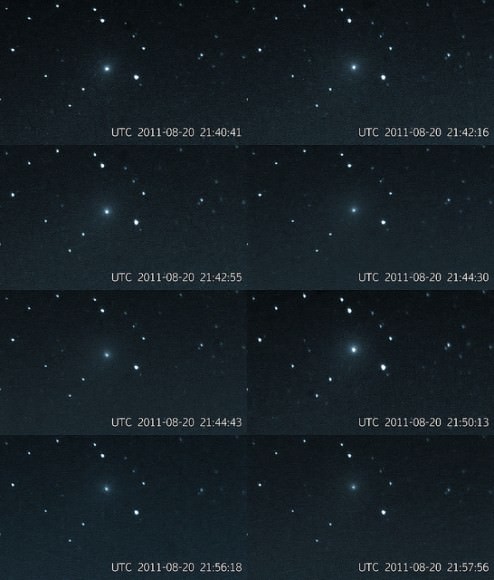
- A collection of images of Comet Garradd from August 20, 2011 by Flickr user 37 Hz.
Supernova PTF11kly in Galaxy M101
If you’re interested – here’s the timing of various celestial events for today from Seattle, courtesy of the U.S. Naval Observatory Astronomical Applications Department:
Sun and Moon Data for One Day
The following information is provided for Seattle, King County, Washington (longitude W122.3, latitude N47.6):
Sunday 4 September 2011 Pacific Daylight Time SUN Begin civil twilight 6:00 a.m. Sunrise 6:32 a.m. Sun transit 1:08 p.m. Sunset 7:44 p.m. End civil twilight 8:16 p.m. End astronomical twilight 9:34 p.m.MOON Moonset 10:40 p.m. on preceding day Moonrise 2:58 p.m. Moon transit 7:16 p.m. Moonset 11:34 p.m. Moonrise 3:53 p.m. on following day
This event is my part of the NASA’s Solar System Ambassadors program, and thanks toWest Seattle Blog for publicizing the last few!
Everyone is welcome, see you there!
![]()
~ A l i c e !
 Live Commentary – Last Shuttle Launch
Live Commentary – Last Shuttle Launch
Are you reading this in a pre-coffee haze? Click on this link:
Alice’s Live Shuttle Launch Comments
Here’s what’s happening, if you’re not in the haze of the uncaffinated early morning:
Provided the weather in Florida holds out, I’ll be commenting live about the final shuttle launch tomorrow morning around 7:30/7:45am Seattle time (PDT). I am still here in Seattle, but since the launch is scheduled for 8:26am our time and Pacific Science Center won’t be open yet, I thought we could chat online.
Joining me will be Sarah Culp, planetarium intern, and Ballard High School graduate (class of ’11!). She and her class sent an experiment with e-coli up on the previous shuttle mission. We’ll probably chat about that as well.
If you want to join us, we’ll be on Twitter (AlicesAstroInfo) using the hashtag #PacSciLive, as well as the official launch hashtag #STS135. You don’t have to sign in to Twitter to read the comments, but you do if you want to talk back. You can also leave comments below, on my Facebook page or e-mail me. I’ll be watching all those for questions from you.
Cross your fingers for good weather in Florida!
![]()
~ A l i c e !
 Rare Lunar Eclipse – June 15, 2011
Rare Lunar Eclipse – June 15, 2011
There is an eclipse on Wednesday June 15, being touted as a rare central lunar eclipse. It is – but it is also very similar to the eclipse we had in December. The “rare” part is that it has a whopping 1 hour and 40 minutes of totality (that’s when the whole face of the moon is darkened by the Earth’s shadow). The eclipse we saw in December had 1 hour and 12 minutes of totality.
Unfortunately, the eclipse is not visible here at all – it peaks at 2:15 in the afternoon, and on Wednesday the Moon will not be visible from Seattle at that time. There is an observatory in Israel that will hook up a live feed to the internet if you want to watch on the web.
Most lunar eclipses I’ve seen have had much shorter periods of totality – though it looks like more than an hour is not uncommon. Between the year 2000 and the year 2020, periods of totality last as little as 5 minutes and up to an hour and a half. Usually they seem to be about an hour.
Want More?
http://eclipse.gsfc.nasa.gov/LEplot/LEplot2001/LE2011Jun15T.pdf
http://www.mreclipse.com/Special/LEnext.html
![]()
~ A l i c e !
 Summer Solstice Sunset Watch – 2011
Summer Solstice Sunset Watch – 2011
I’m back! Time for the seasonal sunset watch!
- When: Tuesday, June 21, 2011 at 9:11pm (so come at 8:45pm)
- Where: Solstice Park – all the way up the hill from the tennis courts (or, if you’re not in Seattle, wherever you have a view of the western horizon!)
- Who: Everyone welcome, as usual.
Come watch the summer solstice sunset at Solstice Park in West Seattle on Tuesday the 21st. We’ll see if the sunset lines up with the placed marker. I’ll be there even if it is cloudy because sometimes the Sun peeks through just as it begins to set, but if it is driving rain I’m staying home.
If you’re interested – here’s the timing of various celestial events on Saturday from Seattle, courtesy of the U.S. Naval Observatory Astronomical Applications Department:
Sun and Moon Data for One Day
The following information is provided for Seattle, King County, Washington (longitude W122.3, latitude N47.6):
Tuesday 21 June 2011 Pacific Daylight Time
SUN
Begin civil twilight 4:31 a.m.
Sunrise 5:11 a.m.
Sun transit 1:11 p.m.
Sunset 9:11 p.m.
End civil twilight 9:52 p.m.MOON
Moonrise 11:56 p.m. on preceding day
Moon transit 5:43 a.m.
Moonset 11:41 a.m.
Moonrise 12:16 a.m. on following day
This event is my part of the NASA’s Solar System Ambassadors program, and thanks to West Seattle Blog for publicizing the last few!
Everyone is welcome, see you there!
![]()
~ A l i c e !
 Seasons “Cheat Sheet”
Seasons “Cheat Sheet”
WARNING: THIS POST IS OVERWHELMING. There is too much information in one place, but I promise there are fun and interesting gems hidden within. It is meant as a reference, and a starting point for discussion of each of these topics.
There are a few numbers and references I am often asked for, especially at the West Seattle solstice and equinox sunset watches. I thought I’d collect these things in one place for “easy” reference.
Strict Definitions (from the USNO)
Equinox – The time at which the Sun passes through one of the two points on the celestial sphere where the celestial equator and the ecliptic intersect. (Yup, pretty technical – the non-technical version is “when the Earth’s axis is pointed neither towards nor away from the Sun.”)
Solstice – The time at which the Sun is at either of the two points on the ecliptic at which the longitude of the Sun is 90° or 270° (halfway between the equinoxes). The non-technical version is “when the Earth’s axis is pointed exactly towards or exactly away from the Sun.”
Horizon – Your eye is considered to be the surface of the Earth, so the horizon is the line exactly straight out from your eyes, or exactly 90 degrees down from the point directly above your head.
Sunrise and Sunset – When “the upper edge of the disk of the Sun is on the horizon, considered unobstructed” (calculations assume a flat horizon). To calculate this exactly, one assumes that this occurs when the Sun is 90.8333° from the zenith (0.8333° below the horizon as defined above). The extra 0.8333° take into account both the radius of the Sun’s disk and an average amount of refraction due to the atmosphere.
Two more notes on rise and set times. First, atmospheric refraction is very important, and small changes in the quality of the atmosphere (humidity, cloud layers, etc) can change apparent rise and set times by at least a minute. Also “at high latitudes … small variations in atmospheric refraction can change the time of rise or set by many minutes, since the Sun and Moon intersect the horizon at a very shallow angle.”
Twilight – there are a few different types of twilight.
Civil Twilight – When the center of the Sun is 6° below the horizon. You can still see during civil twilight, and may not need to turn on outdoor lights. The brightest stars become visible at the beginning or end of civil twilight (“Star light, star bright, first star I see tonight …” you’re still in civil twilight).
Nautical Twilight – When the center of the Sun is 12° below the horizon. You can see objects indistinctly, but you need to turn on lights to do anything detailed.
Astronomical Twilight – When the center of the Sun is 18° below the horizon. The Sun “does not contribute to sky illumination.” It’s dark after astronomical twilight ends.
Change in Amount of Daylight
In Seattle our longest day is about 15 hours 30 minutes, with the shortest night being about 8 hours and 30 minutes. Similarly, our shortest day is about 8 hours 45 minutes, with the longest night being about 15 hours and 15 minutes.
The change in amount of daylight per day varies through the seasons. In Seattle,
- Just before the spring equinox the days are lengthening by about 4 minutes.
- Just before the summer solstice the days are lengthening by significantly less than a minute.
- Just before the fall equinox the days are shortening by about 4 minutes.
- Just before the winter solstice the days are shortening by significantly less than a minute.
Calculate the exact amount of daylight for Seattle or your own location.
Equal Day and Equal Night on the Equinox?
The day and night are not quite equal on the equinox. This is partially due to atmospheric effects and terrain (like mountains or hills), and partially due to your latitude.
At different latitudes the Sun sets at different angles – for instance, at the North Pole it is skimming the horizon, but at the equator it sets almost vertical. Most of us are somewhere in between. It takes longer for the Sun to set when it sets at a shallow angle than at a steep one, and since sunset is defined as when the top edge of the Sun is on the horizon, rather than the center, this gives most of us and uneven day and night on the equinoxes.
Sun Angles for Seattle
- Angle of sunrise and sunset for Seattle is always: 43°
- Summer solstice maximum height of the Sun (highest the Sun ever gets in Seattle): 66°S
- Equinox maximum height of the Sun in Seattle: 43°S
- Winter solstice maximum height of the Sun (lowest “high point” of the Sun’s path through the year): 19°S
Earliest Sunrise/Latest Sunset
Latest Sunrise/Earliest Sunset
See my Dark Days of Winter post. Or the one by the USNO.
Dates and Times (Seattle Local)
2011
|
2012
|
2013
|
2014
|
2015
|
Daylight Savings Time (USA, as of 2011)
- Second Sunday in March – spring forward – daylight time begins, 2:00am becomes 3:00am. Lose an hour.
- Pacific Daylight Time is 7 hours earlier than Universal Time (UTC).
- First Sunday in November – fall backward – standard time begins, 2:00am becomes 1:00am. Gain an hour.
- Pacific Standard Time is 8 hours earlier than Universal Time (UTC).
Slippage – Are the Equinoxes Moving?
Since the introduction of the Gregorian Calendar with its crazy leap days every 4 years (except for every 100 years (except for every 400 years)) … we’ve made it so the date we call the spring equinox (March 21) will take 3300 years to get one full day out of sync with the time the Earth is at the actual position of the spring equinox.
This could be interpreted to mean the vernal equinox is slipping by one minute every 2-3 years on average, but you will notice hours more slippage year to year, because leap days correct for the length of the year over a 400-year cycle, not continuously. Between leap years we accumulate “error.” This error is corrected all at once by a leap day, or lack of a leap day.
Example (ignore if you don’t find numbers helpful): each year the equinox is about 5 hours and 45 minute later, but on a leap year it is both 5 hours 45 minutes later AND one day earlier (or simply approximately 18 hours and 15 minutes earlier if you prefer). This in turn accumulates a slip of about 45 minutes every 4 years, which is mostly corrected for only when we skip a leap day on the 100th year.
(Are you math-y? This may help you: We correct for the error discretely, rather than continuously.)
Too much? Think of it as a ratchet that resets every 4, 100, and 400 years to almost the exact beginning position. Each ratchet motion is noticeable, but after you’ve reset it’s pretty unnoticeable.
Movement of Perihelion and Aphelion
You’d think perihelion (Earth’s point nearest the Sun) and aphelion (Earth’s point farthest from the Sun) would be as set in place in our orbit as the equinoxes and the solstices. Not so. Since the Moon and Earth orbit a common center of gravity, the Moon’s orbit causes the Earth to be slightly closer or farther from the Sun at any given time. Since the Moon isn’t in the exact same point in its orbit each year when we reach the approximate location of perihelion or aphelion, this disturbance in our orbit causes a slight change in that location year to year.
Links I Use in Planning Seasonal Events
Dates of Earth’s Primary Seasons – This is where I get the exact day and time of each solstice and equinox. This is in Universal Time (UTC) and must be converted to your local time.
Time Zone Converter – This is where I go to convert the time from the link above (solstice or equinox) from Universal Time (UTC) into Pacific Time. I use “USA – Washington – Seattle” rather than Pacific Standard Time or Pacific Daylight Time so I don’t have to remember when we switch off of Daylight Savings. Which, by the way, I look up here if I need to.
- PST is 8 hours earlier than UTC.
- PDT is 7 hours earlier than UTC.
Complete Sun and Moon Data for One Day – This is where I get the time of the Seattle sunset for each sunset watch.
Definitions of Rise, Set, and Twilight
![]()
~ A l i c e !
 Spring Equinox Sunset Watch – 2011
Spring Equinox Sunset Watch – 2011
Yup! It’s that time again. Time for the quarter-annual sunset watch … only this time I’ll be 8.25 months pregnant when we meet!
- When: Sunday, March 20, 2011 at 7:22pm (so come at 7:00pm)
- Where: Solstice Park – all the way up the hill from the tennis courts (or, if you’re not in Seattle, wherever you have a view of the western horizon!)
- Who: Everyone welcome, as usual.
Come watch the spring equinox sunset at Solstice Park in West Seattle on Sunday the 20th. We’ll see if the sunset lines up with the placed marker. I’ll be there even if it is cloudy because sometimes the Sun peeks through just as it begins to set, but if it is driving rain or sleet I’m staying home with a cup of tea.
If you’re interested – here’s the timing of various celestial events on Saturday from Seattle, courtesy of the U.S. Naval Observatory Astronomical Applications Department:
Sun and Moon Data for One Day
The following information is provided for Seattle, King County, Washington (longitude W122.3, latitude N47.6):
Sunday 20 March 2011 Pacific Daylight Time
SUN
Begin civil twilight 6:42 a.m.
Sunrise 7:13 a.m.
Sun transit 1:17 p.m.
Sunset 7:22 p.m.
End civil twilight 7:53 p.m.MOON
Moonrise 7:57 p.m. on preceding day
Moon transit 1:41 a.m.
Moonset 7:12 a.m.
Moonrise 9:21 p.m.
Moonset 7:41 a.m. on following dayPhase of the Moon on 20 March: waning gibbous with 98% of the Moon’s visible disk illuminated.
Full Moon on 19 March 2011 at 11:11 a.m. Pacific Daylight Time.
This event is my part of the NASA’s Solar System Ambassadors program, and thanks to West Seattle Blog for publicizing the last few!
Everyone is welcome, see you there!
![]()
~ A l i c e !
